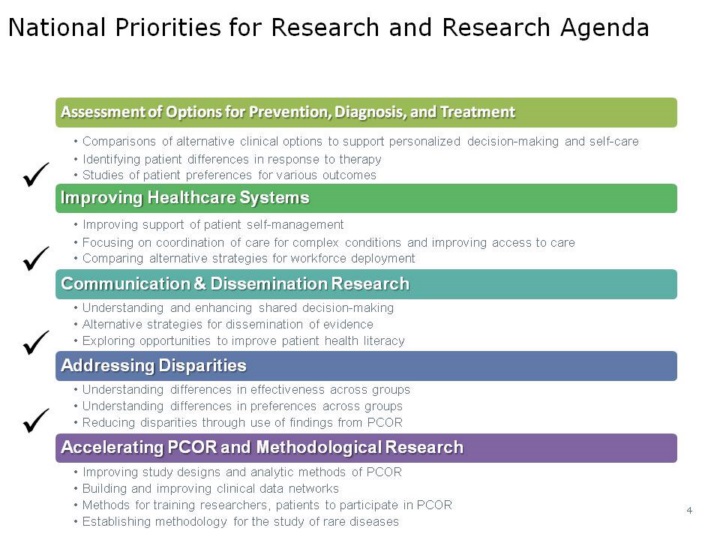| front |1 |2 |3 |4 |5 |6 |7 |8 |9 |10 |11 |12 |13 |14 |15 |16 |17 |18 |19 |20 |21 |22 |23 |24 |25 |26 |27 |28 |29 |30 |31 |32 |33 |34 |35 |review |
 |
sourced from:http://www.slideshare.
What is the purpose of the Research Agenda? The Research Agenda describes the types of research questions that can be addressed under each of the five priorities. The agenda also outlines nine criteria, taken from PCORI’s establishing legislation, which will be used to evaluate research proposals. Studies that meet most or all of these criteria will be those most likely to be funded.
Why doesn’t the Research Agenda name specific conditions or treatments that PCORI is interested in funding or studying? PCORI believes there are important comparative clinical effectiveness research questions to be answered across a wide range of conditions. Focusing on a narrower set of diseases or conditions at the start of PCORI’s research funding would mean that some patients and health care issues might have no chance of benefitting from PCORI’s existence. Also, there are issues that affect patients across a variety of conditions. For example, we have heard from the patient focus groups about challenges with communication and interaction with their providers. These are problems that are not specific to one condition, but have been identified by a variety of patients as being important to them. Involving patients and other stakeholders in a meaningful process of considering which conditions or questions deserve more PCORI funding is important and will begin immediately and continue throughout PCORI’s lifetime.
However, it will take time to hear all views on these issues, to weigh the input, and to begin making these choices. This must be done in a transparent manner so that all can understand how we reached the narrower, targeted set of research questions we focus on. Over time, PCORI’s research portfolio will become more focused, but PCORI will continue to reserve a portion of its funding for addressing the broader set of possible questions that patients, researchers and stakeholders may raise.
|